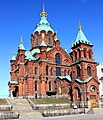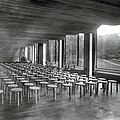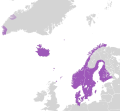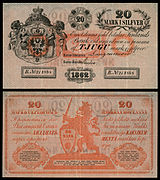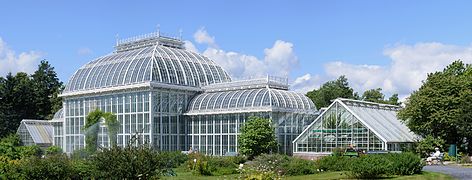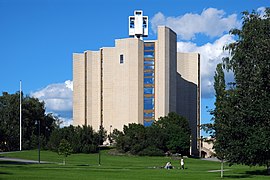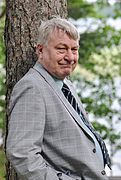Portal:Finland
The Finland Portal


Finland, officially the Republic of Finland, is a Nordic country in Northern Europe. It borders Sweden to the northwest, Norway to the north, and Russia to the east, with the Gulf of Bothnia to the west and the Gulf of Finland to the south, opposite Estonia. Finland covers an area of 338,145 square kilometres (130,559 sq mi) and has a population of 5.6 million. Helsinki is the capital and largest city. The vast majority of the population are ethnic Finns. The official languages are Finnish and Swedish, of which 84.9 percent of the population speak the first as their mother tongue and 5.1 percent the latter. Finland's climate varies from humid continental in the south to boreal in the north. The land cover is predominantly boreal forest biome, with more than 180,000 recorded lakes.
Finland was first settled around 9000 BC after the last Ice Age. During the Stone Age, various cultures emerged, distinguished by different styles of ceramics. The Bronze Age and Iron Ages were marked by contacts with other cultures in Fennoscandia and the Baltic region. From the late 13th century, Finland became part of the Swedish Empire as a result of the Northern Crusades. In 1809, as a result of the Finnish War, Finland was captured from Sweden and became a Grand Duchy of Finland, an autonomous state ruled by the Russian Empire. During this period, Finnish art flourished and the idea of full independence began to take hold. In 1906, Finland became the first European state to grant universal suffrage, and the first in the world to give all adult citizens the right to run for public office. Following the Russian Revolution of 1917, Finland declared its full independence. In 1918 the young nation was divided by the Finnish Civil War. During World War II, Finland fought against the Soviet Union in the Winter War and the Continuation War, and later against Nazi Germany in the Lapland War. As a result, it lost parts of its territory but retained its independence. (Full article...)
Selected article -
The Winter War was a war between the Soviet Union and Finland. It began with a Soviet invasion of Finland on 30 November 1939, three months after the outbreak of World War II, and ended three and a half months later with the Moscow Peace Treaty on 13 March 1940. Despite superior military strength, especially in tanks and aircraft, the Soviet Union suffered severe losses and initially made little headway. The League of Nations deemed the attack illegal and expelled the Soviet Union from its organization.
The Soviets made several demands, including that Finland cede substantial border territories in exchange for land elsewhere, claiming security reasons – primarily the protection of Leningrad, 32 km (20 mi) from the Finnish border. When Finland refused, the Soviets invaded. Most sources conclude that the Soviet Union had intended to conquer all of Finland, and cite the establishment of the puppet Finnish Communist government and the Molotov–Ribbentrop Pact's secret protocols as evidence of this, while other sources argue against the idea of a full Soviet conquest. Finland repelled Soviet attacks for more than two months and inflicted substantial losses on the invaders in temperatures as low as −43 °C (−45 °F). The battles focused mainly on Taipale along the Karelian Isthmus, on Kollaa in Ladoga Karelia and on Raate Road in Kainuu, but there were also battles in Salla and Petsamo in Lapland. (Full article...)Selected image -

Photo credit: commons:User:AngMoKio
Mika Häkkinen driving a Mercedes-Benz DTM racing car at Stars and Cars in Stuttgart, Germany.
Did you know (auto-generated)

- ... that Charlotte Haining was an International Jury Member for the selection of Finland's 2020 Eurovision Song Contest entry?
- ... that Kimmo Leinonen helped establish both the Finnish Hockey Hall of Fame and the IIHF Hall of Fame?
- ... that Finnish linguist Eeva Leinonen was one of four women to be inaugurated as heads of Irish universities in 2021, the others being Maggie Cusack, Linda Doyle and Kerstin Mey?
- ... that records of transgender people in Finland stretch back to the 19th century?
- ... that the 1972 Finnish film The Sheep Eaters gathered more than a million viewers opposite the 1975 Ice Hockey World Championships match between Finland and the Soviet Union?
- ... that Matti Lehtinen, a baritone of the Finnish National Opera and professor of singing at the Sibelius Academy, was the voice of God at age 93?
WikiProjects

You are invited to participate in Finland WikiProject, a WikiProject dedicated to developing and improving articles about Finland.
More did you know -
- ...that when completed in 1967, MS Finlandia was the largest ferry in the world?
- ...that the Pysähdy ajoissa - Stanna i tid ("Stop in time") traffic campaign was the result of the public response to a road death of a nine-year-old girl in Finland?
- ...that the Finnish Association of Graduate Engineers has been in charge of publishing Finland's ethical guidelines on engineering for over 40 years?
- ...that Penedo, a small town in Brazil was colonized by immigrants from Finland?
- ...that the Wärtsilä Turku shipyard in Finland built five state-of-the-art cruiseferries for the Black Sea Shipping Company, Soviet Union, in 1975-1976?
During World War II, the Lapland War (Finnish: Lapin sota; Swedish: Lapplandskriget; German: Lapplandkrieg) saw fighting between Finland and Nazi Germany – effectively from September to November 1944 – in Finland's northernmost region, Lapland. Though the Finns and the Germans had been fighting together against the Soviet Union since 1941 during the Continuation War (1941–1944), peace negotiations between the Finnish government and the Allies of World War II had been conducted intermittently during 1943–1944, but no agreement had been reached. The Moscow Armistice, signed on 19 September 1944, demanded that Finland break diplomatic ties with Germany and expel or disarm any German soldiers remaining in Finland.
The Wehrmacht had anticipated this turn of events and planned an organised withdrawal to Nazi-occupied Norway, as part of Operation Birke (Birch). Despite a failed offensive landing operation by Germany in the Gulf of Finland, the evacuation proceeded peacefully at first. The Finns escalated the situation into warfare on 28 September after Soviet pressure to adhere to the terms of the armistice. The Finnish Army was required by the Soviet Union to push Wehrmacht troops out of Finnish territory. After a series of minor battles, the war came to an effective end in November 1944, when all of the Wehrmacht troops had reached Norway or the border area and took fortified positions. The last Wehrmacht soldiers left Finland on 27 April 1945, shortly before the end of World War II in Europe. (Full article...)General images
In the news
- 9 June 2024 – 2024 European Parliament election
- The last day of the European elections is taking place with votes in Austria, Belgium, Bulgaria, Croatia, Cyprus, Denmark, Finland, France, Germany, Greece, Hungary, Lithuania, Luxembourg, Poland, Portugal, Romania, Slovenia, Spain, Sweden and for the second day in Italy. (AP)
- 22 May 2024 – Russia–NATO relations
- The Russian Ministry of Defence proposes to unilaterally adjust Russia's maritime border in the Baltic Sea, prompting comments of concern made by Baltic members of NATO, including Finland and Lithuania. The Ministry of Defense later retracts the proposal. (Reuters) (BBC News)
- 2 April 2024 – Viertola school shooting
- A student is killed and two others are injured in a shooting at a school in Vantaa, Uusimaa, Finland. A 12-year-old student is detained. (AP) (Yle)
- 1 March 2024 – 2024 Finnish presidential election
- Alexander Stubb is sworn in as the 13th President of Finland. (Reuters)
- 11 February 2024 – 2024 Finnish presidential election
- Alexander Stubb is elected President of Finland with 51.6% of the vote.(Yle)
- 27 January 2024 – Israel–Hamas war
- The United Kingdom, United States, Australia, Italy, Canada, Finland, the Netherlands, Switzerland, and Germany suspend humanitarian aid to UNRWA over allegations that some UNRWA staff members were involved in the Hamas-led attack on Israel. (BBC News) (CBS News)
Related portals
Northern Europe
Other countries
Selected panorama -
Topics
Categories
Recognized content
Things you can do
- Add the {{Portal|Finland}} template to existing See also sections of Finland-related articles.
- Tag the talk pages of Finland-related articles with the {{WikiProject Finland}} template. (Tip: Use PetScan to find articles not tagged yet by replacing the category "Finnish films" with another category and adjust "Depth" if needed. This tool is helpful for tagging. See also the list of pages not tagged yet.)
- Rate unassessed and unknown-importance articles according to the guidelines. (This tool is helpful for doing these.)
- Translate a Finnish-language article into English.
- Expand a stub into a full article.
- Help with the articles needing attention (watch) and cleanup.
- Create a requested article (watch).
- Support fresh articles (watch).
- Patrol the recent changes.
- Add the following pages to your watchlist:
Associated Wikimedia
The following Wikimedia Foundation sister projects provide more on this subject:
-
Commons
Free media repository -
Wikibooks
Free textbooks and manuals -
Wikidata
Free knowledge base -
Wikinews
Free-content news -
Wikiquote
Collection of quotations -
Wikisource
Free-content library -
Wikiversity
Free learning tools -
Wikivoyage
Free travel guide -
Wiktionary
Dictionary and thesaurus








